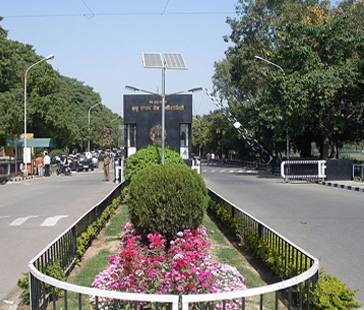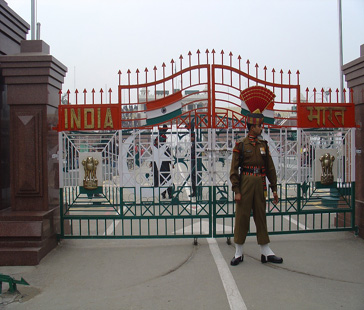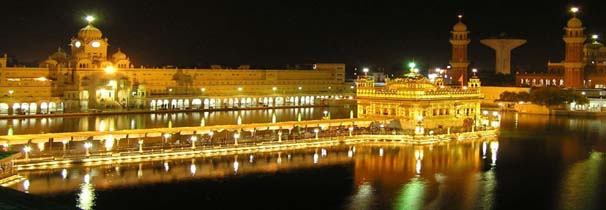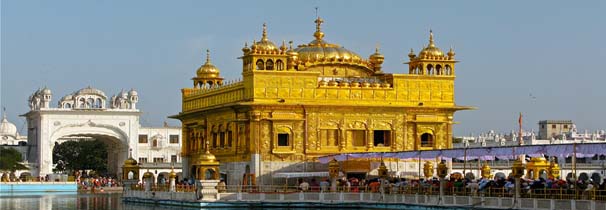Weather Guidelines:
Amritsar in Punjab experiences extreme type of climate. The summers are too hot and winters are too cold. Best Time to visit Amritsar is in the months of February and March as the climate is cool and pleasant. Day temperature varies from 12 degrees to 16 degrees Celsius whereas night temperature varies from 8 degrees to 12 degrees Celsius. The participants are advised to carry one or two woolen clothes to keep them warm.
Places of interest:
Golden temple(Harmander Sahib)
The Golden temple is located in the holy city of the Sikhs, Amritsar. The Golden temple is famous for its full golden dome, it is one of the most sacred pilgrim spots for Sikhs. The Mandir is built on a 67-ft square of marble and is a two storied structure. Maharaja Ranjit Singh had the upper half of the building built with approximately 400 kg of gold leaf. The Golden Temple is surrounded by a number of other famous temples like the Durgiana Temple. The fourth Guru of Sikhs, Sri Guru Ram Das Ji, who had initially constructed a pool here, founded Amritsar, which houses the Golden Temple or Harmandir Sahib. To the south of the temple is a garden, and the tower of Baba Atal. The Central Sikh Museum is atop the Clock Tower. The 'Guru Ka Langar' offers free food to around 20,000 people everyday. The number shoots up to 100,000 on special occasions. A visitor must cover his / her head before entering the temple premises. Sri Guru Granth Sahib Ji (the holy book of the Sikhs) is kept in the Temple during the day and is kept in the Akal Takht or Eternal Throne in the night. The Akal Takht also houses the ancient weapons used by the Sikh warriors. The sixth Guru, Sri Guru Hargobind Sahib Ji, established it. The rugged old Jubi Tree in the north west corner of the compound is believed to possess special powers. It was planted 450 years ago, by the Golden Temple's first high priest, Baba Buddha Ji. Guru-ka-Langar or the communal canteen is towards the eastern entrance of the temple complex, and it provides free food to all visitors, regardless of colour, creed, caste or gender. Visitors to the Golden Temple must remove their shoes and cover their heads before entering the temple. The temple is less crowded in the early mornings on weekends.
Around the Golden Temple
Within the sacred precincts of the Golden Temple, a devotee can seek blessing at:
The Akal Takht
Har Ki Pauri
Dukh Bhanjani Ber (Jujube Tree)
Thara Sahib
Ber Baba Budha Ji
Gurudwara Ilachi Ber
Ath Sath Tirath
Bunga Baba Deep Singh
Durgiana Temple (Lakshmi Narain Temple)
Built in the third decade of the 20th Century it echoes, not the traditional Hindu temple architecture, but that of the Golden Temple and, in a similar manner rises from the midst of a tank and has canopies and the central dome in the style of the Sikh temple. One of the greatest reformers and political leaders of resurgent India, Pandit Madan Mohan Malviya Ji, laid its foundation stone. It is a well-known repository of Hindu scriptures
Wagah Border
The international border between India and Pakistan. The pomp and pageantry of the Beating Retreat and the Change of Guard within handshaking distance of the Indian and Pakistani forces makes for a most charming spectacle.
Wagah, an army outpost on Indo-Pak border - between Amritsar and Lahore, is an elaborate complex of buildings, roads and barriers on both sides. The daily highlight is the evening "Beating the Retreat" ceremony. Soldiers from both countries march in perfect drill, going through the steps of bringing down their respective national flags. As the sun goes down, nationalistic fervour rises and lights are switched on marking the end of the day amidst thunderous applause.
Jallian Wala Bagh
The memorial at this site commemorates the 2000 Indians who were killed or wounded, shot indiscriminately by the British under the command of Gen Michael O"Dyer on April13, 1919 while participating in a peaceful public meeting. This was one of the major incidents of India's freedom struggle.The story of this appaling massacre is told in the Martyr's Gallery at the site. A section of wall with bullet marks still visible is preserved along with the memorial well, in which some people jumped to escape. "Men of India shall rise and liberate their mother land", declared Mahatma Gandhi, after the Jallian Wala massacre. "This disproportionate severity of punishment inflicted upon the unfortunate people and method of carrying it out is unparalleled in the history of civilized govt." wrote Rabindra Nath Tagore the noble laureate while returning knighthood.
Ram Bagh
Ram Bagh a beautiful garden ,an accustomed listener to the Neighs of thousand horses, announcing the arrival of the statesman of the century Maharaja Ranjit Singh (1780-1839) the Lion of Punjab, has in its heart the summer Palace of this great ruler. Maintenance free inbuilt cooling system designed in the Palace exhibits the architectural excellence and invokes a keen interest.The king of his time brought local chieftains under his control and virtually finished any eventuality of possible attacks on the kingdom raised by him. To commemorate the memory of his velour Ram Bagh on its one end has a lively statue of Maharaja Ranjit Singh saddled on a horse in a winsome posture.
The garden was named by the ruler himself as a tribute to Sri Guru Ram Das Ji, the founder of the city. Now the summer palace of the Maharaja Ranjit Singh has been converted into a museum which speaks volumes on his times.On display are weapons dating back to Mughal times, portraits of ruling houses of Punjab and a replica of diamond "Kohinoor". In those days the garden was approached by a huge fortified gate which still exists in its original form and is just on the periphery of the garden.
Ram Tirath
Located 11 Km West of Amritsar on Chogawan road, dates back to the period of Ramayana, Rishi Valmiki's hermitage. The place has an ancient tank and many temples. A hut marks the site where Mata Sita gave birth to Luv & Kush and also, still extant are Rishi Valmiki's hut and the well with stairs where Mata Sita used to take her bath. The Bedis of Punjab (Sri Guru Nanak Dev Ji , the founder Prophet of Sikhism was a Bedi) trace their descent from Kush and Sodhis (the 10th Prophet of Sikhism, Sri Guru Gobind Singh Ji was a Sodhi) from Luv. A four day fair, since times immemorial is held here starting on the full moon night in November. 16 Kilometres west on Choganwan road is Ram Tirath, commemorating Maharishi Valmiki Ji´s heritage.
Pul Kanjari:
It is another heritage sight built by Maharaja Ranjit Singh around which are sewn many tales and legends. Situated near the villages of Daoka and Dhanoa Kalan right on the Wagha border, Pul Kanjari is about 35 kms both from Amritsar & Lahore. The Maharaja would often rest and leisure here in the baradari while passing by along with his royal troop and retinues. Despite a ruined fort and a baoli-a bathing pool - this heritage sight has a temple, a Gurudwara and a mosque which bespeak of the secular concerns of the Maharaja. The inside of the dome on the corner of the baoli enshrines a number of scenes and sights from the Hindu scriptures and the Raj Darbar.These frescoes are laced with floral frames.
Jama Masjid Khairuddin:
Built by Mohd. Khairuddin in 1876, this masjid is a place of architectural beauty situated in the Hall Bazar. This is the holy place from where a call against the British rule was given by Tootie-e-Hind, Shah Attaullah Bukhari.
Samadh of Shravan:
About 6 Kilometres from Ajnala near Jastarwal (earlier known as Dashrathwal) is located one of the oldest heritage spots in Amritsar. It belongs to the Ramayana period a legend has it that Shravan lies buried here after the fell from the arrow of King Dashrath, the Lord of Ayodhya. The Samadh is situated on the banks of an old rivulet (Purani Dhab ).Shravan had taken his blind parents on a wide-ranging pilgrimage by cradling them on his shoulder in a wooden device.
Khoo Kalyanwala :
The city has played a stellar role in the liberation of India from the British clutches. Freedom fighters like Madan Lal Dhingra, Ras Bihari Bose, S.Kartar Singh Sarabha, Dr. Satya Pal and Dr. Saif-ud-din Kitchlu are house-hold names in Amritsar.When Mangal Pande blew the bugle of rebellion against the British in 1857, its echoes and shock-waves were felt in Amritsar also. A platoon of 400 soldier stationed at Lahore rebelled against the British Government by fleeing their barracks. The deserted soldiers bravely swam across the flooded Ravi and reached Ajnala.The information was received by Mr.Fredric Cooper, the then Deputy Commissioner of Amritsar.On his order, all of them were put in a coop-like room where almost 200 soldiers died of asphyxia. The rest of them were brutally shot dead the next morning and their dead bodies thrown in the well which is known as the Kalianwala Khoo in Tehsil Ajnala.
The Historical Banyan Tree( Shaheedi Bohr):
This historical tree with massive girth and lushgreen canopy stands majestically in the Namdhari Shaheedi Samark against the majestic back drop of the northern boundary of Ram Bagh.Four Kookas were hanged from this tree by the British Government in 1871. The Kookas were hanged because they had reacted violently against the hawking of beef around the Golden Temple.













